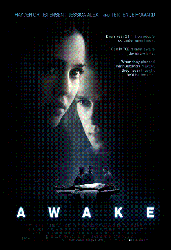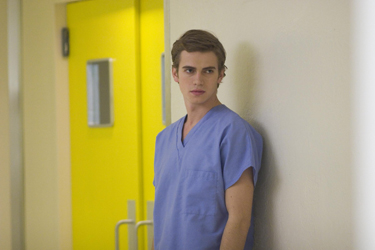 Anaesthetics were first used in 4200 BC in the form of opium poppy capsules. Even today, it is used in surgery for its pain suppression properties. Today, however, a cocktail of drugs is administered to a patient to induce amnesia, suppress pain, relax muscles and paralyse reflexes, among others.
Anaesthetics were first used in 4200 BC in the form of opium poppy capsules. Even today, it is used in surgery for its pain suppression properties. Today, however, a cocktail of drugs is administered to a patient to induce amnesia, suppress pain, relax muscles and paralyse reflexes, among others.
If too much anaesthesia is given, the overdose could be fatal. But what happens if muscle relaxants are administered, effectively immobilising the patient, with an insufficient dosage of painkillers?
Synopsis
Film Structure (spoilers)
Character Development (spoilers)
The (Operating) Theatre Of Actors
Plot Logic, Lapses and Inconsistencies (spoilers)
Verdict
Synopsis
In Awake , young billionaire Clayton Bereseford, Jr. (Hayden Christensen ), has to undergo a heart transplant surgery. Hours earlier, the businessman, better known as Clay, married his fiancé Samantha Lockwood (Jessica Alba ), better known as Sam, despite his mother’s vehement objections.
Just as foolishly, he declines the services of top cardiologist Dr
Neyer because he trusts Dr Jack Harper (Terrence Howard ), who faces a number of malpractice lawsuits, because Harper saved his life during a cardiac arrest.
 Now, Clay lies on the surgical table. For unknown reasons, the anaesthesiologist is replaced last minute. “The players have been changed, but the game remains the same,” Dr Putnam, Dr Harper’s accompanying surgeon, remarks cryptically.
Now, Clay lies on the surgical table. For unknown reasons, the anaesthesiologist is replaced last minute. “The players have been changed, but the game remains the same,” Dr Putnam, Dr Harper’s accompanying surgeon, remarks cryptically.
Clay’s eyes are taped shut to prevent his corneas from drying out. A voice-over starts, conveying his thoughts to the audience. He feels Dr Harper’s hand resting on his sternum, and then, the cold steel of the scalpel searing through his chest. He starts screaming, albeit through the voice-over.
In his pain, Clay goes into an out-of-body experience, where he uncovers a convoluted murder conspiracy that will devastate the foundations of trust he has in the closest people around him.
Film Structure
Awakehas an excellent film structure. If this story were to be told in a more conventional fashion, it will doubtlessly bore the audience with its predictability. Instead, this film reveals a conspiracy plan that slaps you in the face, jerking even the most seasoned filmgoer out of the arrogant “I know what’s happening next” mindset.
As the story moves on, jigsaw pieces fall into place, enlightening the audience with Eureka episodes as seemingly inconsequential details develop into major plot devices.
Director Joby Harold says of his directorial movie debut in the production notes, “In most thrillers, the audience sees the main character walking down a hallway and knows that there’s a bad man around the corner, that danger is near. In our film, I’m hoping to make Clay’s experience happen right in the middle of the audiences’ head.” He added, “We’re trying to make the experience as visceral, as immediate, and as identifiable as possible, so it’s something the audience can actually feel in real time. It will be like a ride.”
It is precisely this structure that makes it very difficult to write an in-depth movie review and analysis without including essential details that might spoil the surprises that this film relies heavily on. Don’t proceed if you intend to watch the film. Use the anchor links above to read more about the actors and verdict.
The film opens with Dr Harper bending over a photo frame with pictures of him and Clay, apparently in depression. It appears that Clay died in an unsuccessful operation. “You may think you understand when or why or how it happens,” he says plaintively. “You can’t.”
The story is then told in a flashback. Being a good friend, Dr Harper was trying to convince Clay to live life to the fullest and marry his fiancée.
What you don’t know, until much later, is that it was the doctor’s idea to inject Clay’s new heart with a chemical that will cause the rejection of the organ. They have been pushing Clay down the transplant waiting list until he marries Sam. Because of Clay’s extremely rare blood type, they will not be able to find a suitable heart in time to save his life. He will die, leaving an inheritance of US$100 million to split among the surgeon, Sam, Dr Putnam and nurse Carver.
Character Development
This psychological thriller has an introduction so long it takes up more than a quarter of the total runtime. In fact, the flashback after Dr Harper’s opening monologue, was thrown so far into the past that one is momentarily disoriented and unable to even establish a relationship between the flashback and the monologue.
“The movie only started when the operation began,” an audience member was overheard saying after the film. This UrbanWire writer feels that such a statement could only be made in ignorance.
While it’s true that the impatient might not have the stamina to stay intrigued, the introduction, which was surprisingly neither dreary nor superfluous, helped build 3-dimensional personalities in the film’s characters.
By giving the audience little insights into the lives of each character, the audience is encouraged to draw their own conclusions, forming a mental impression of each character in their heads. Then the film goes one step further and smashes each mental impression by revealing another dimension in the character the audience didn’t previously know, destroying antagonist typecasts that most films have, and allowing the audience to relate to the characters as imperfect human beings, and not mere fictional creations.
For example, even when Dr Harper was to inject the heart with the lethal chemical, he felt a tremendous amount of guilt and fear and almost changed his mind. He only did it under great pressure from the rest of the team. “Jack, grow some f***ing balls,” Sam snapped at him, before placing the syringe in his hand and dictating exactly what he should do. “He really did love you, Sam,” Jack said, as Sam walked out of the operating theatre.
What was even more impressive was the development of the relationship between Clay and Lilith, his mother. While Lilith was seen mostly through the film as the overbearing and possessive mother, who threatened to disown her son if he continues dating Sam, it’s obvious that they share great love between them. Later, she makes a stunning decision to kill herself so that her heart can be used in place of the poisoned organ.
It was subsequently revealed that Clay’s memories of his dad’s death were self-altered so that the perfect image of his dad was retained; Lilith had killed Clayton Bereseford, Snr, a cocaine addict, to protect her son. The emotional tension in the cinema at this point of time is clearly perceptible.
The (Operating) Theatre Of Actors
 Such superb character development was complemented by performers as talented as they’re beautiful. This came as a delightful surprise as Christensen and Alba are infamous for their inept and unconvincing acting, with the former earning a Razzie award for his performance in the Star Warsseries.
Such superb character development was complemented by performers as talented as they’re beautiful. This came as a delightful surprise as Christensen and Alba are infamous for their inept and unconvincing acting, with the former earning a Razzie award for his performance in the Star Warsseries.
While Alba is very convincing as Sam, it would be more prudent to cast another actress who has the emotional strength to demonstrate the multiple facets in her character. Unlike Howard, who played Jack, Alba vacillates between the 2 extremes – the lover and the murderer, with no grey areas in between.
Lena Olin , who played Lilith, also deserves special mention for conveying her character’s emotions, within the impassive confines that are typically expected of a member of the haute monde, with her nuanced performance.
Plot Logic Lapses and Inconsistencies
However, even though details that add verisimilitude to the film, such as a janitor mopping the floor of the church where Jack and Sam held their impromptu wedding, have been meticulously included, Awake falls short in addressing other crucial logic lapses and inconsistencies.
Clay runs around, in his out-of-body experience, in hospital scrubs. It is not known why, because he was last seen lying down in the operating theatre in a surgical gown. People also seem to be able to enter and leave operating theatres freely, violating the sterile field , not to mention, the privacy and safety of the patient.
A series of medical faux pas are also embarrassingly obvious to anyone with a rudimentary understanding of medicine. It is unlikely that Lilith’s heart can still be used for transplant, as she was dead for some time before the transplant took place, depriving her heart of oxygen. It is also puzzling that Lilith should take her life using her son’s medicine, reducing her blood pressure drastically and endangering the health of her heart. Doctors in the audience would probably cringe at the very unlikely sight of top cardiologist Dr Neyer scrubbing down over Clay’s chest just after sewing it shut.
On a more serious note, this film downplays the seriousness of anaesthesia awareness . It is a real medical problem that leaves its victims with debilitating traumatic after-effects. Unlike Clay, who seems to have lost his ability to feel pain in the later part of the film, the real victims of anaesthesia awareness suffer immense pain throughout their surgery.
To begin with, the decision to use anaesthesia awareness as a marketing strategy is a puzzling one. It gives the false impression that this film is a medical thriller/documentary. In reality, this rare medical phenomenon acts as a plot device to a murder conspiracy, which forms the actual plot content.
In his out-of-body experience, Clay’s surroundings darken as his real self dies. While this could prove to be an interesting cinematography technique, it resembles a poorly executed metaphor that fell flat on its face. Additionally, the last scene was disappointing and doesn’t put proper closure to a film highly charged with emotional tension.
UrbanWire also doesn’t understand this film’s seeming bias against Japan. In this film, there are at least 3 instances that refer Japan, and/or its people, as “ruthless”. While not detrimental to the film, such actions makes one wonder about the agenda of Awake.
What this UrbanWire writer finds it most unforgivable is that Awake bears no real semblance of plot. Granted, it is difficult to develop much plot with a man who lies on his back in an operating theatre throughout the film, but, at 85 minutes, this film could afford more time to develop a greater depth in the plot.
It is a colossal waste, because if this film is handled with more finesse, it has a very real potential of developing into a definitive piece of work, along the likes of The Butterfly Effect .
Nevertheless, Awake is an emotionally gratifying experience, especially if you’re a person of sentiment. By the time this film ended, some of its audience were visibly in tears – certainly not from pain, UrbanWire can assure you.
Yes, there are numerous bad reviews written about Awake, and those reviews are not without merit, especially if it’s written for an audience in a different country who are more accustomed to the blood and gore of Saw .
But judging from Singaporeans’ obsessions with love ballads, like Colin Raye’s “Love Me”, and their fervent love for Jack Neo’s no-plot emotional films, UrbanWire is confident that the flaws in this film will be ignored for its stronger tugging of the audience’s heartstrings.
UrbanWire gives Awake 3.5 out of 5 stars
Movie Details
Opens: 17 Apr 2008
Movie Rating: R21
Running Time: 85 mins
Language: English
Director: Joby Harold
Cast: Jessica Alba, Hayden Christensen, Lena Olin, Terrence Howard

